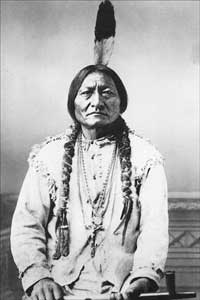
Back لاكوتا (قبيلة) Arabic لاكوتا (قبيله) ARZ لاکوتا خالقی AZB Lakota BAR Лакота Byelorussian Лакота BE-X-OLD Nació Lakota Catalan Lakota (pobl) Welsh Lakota Danish Lakota German
 | |
| Total population | |
|---|---|
| 115,000+ enrolled members[1][2][3][4][5] (2015 census) | |
| Regions with significant populations | |
| United States (North Dakota and South Dakota) Canada (Manitoba and Saskatchewan) | |
| Languages | |
| English, Lakota | |
| Religion | |
| Wocekiye, Lakota religion | |
| Related ethnic groups | |
| Other Sioux peoples (Santee, Sisseton Wahpeton Oyate, Yankton, Yanktonai)[6] |
| Lakota transl. "ally" or "friend" | |
|---|---|
| People | Lakȟóta Oyáte |
| Language | Lakȟótiyapi Wíyutȟapi |
| Country | Lakȟóta Makóce, Očhéthi Šakówiŋ |
The Lakota ([laˈkˣota]; Lakota: Lakȟóta/Lakhóta) are a Native American people. Also known as the Teton Sioux (from Thítȟuŋwaŋ), they are one of the three prominent subcultures of the Sioux people, with the Eastern Dakota (Santee) and Western Dakota (Wičhíyena). Their current lands are in North and South Dakota. They speak Lakȟótiyapi—the Lakota language, the westernmost of three closely related languages that belong to the Siouan language family.
The seven bands or "sub-tribes" of the Lakota are:
- Sičháŋǧu (Brulé, Burned Thighs)
- Oglála ("They Scatter Their Own")
- Itázipčho (Sans Arc, Without Bows)
- Húŋkpapȟa (Hunkpapa, "End Village", Camps at the End of the Camp Circle)
- Mnikȟówožu (Miniconjou, "Plant Near Water", Planters by the Water)
- Sihásapa ("Blackfeet” or “Blackfoot")
- Oóhenuŋpa (Two Kettles)
Notable Lakota persons include Tȟatȟáŋka Íyotake (Sitting Bull) from the Húnkpapȟa, Maȟpíya Ičáȟtagya (Touch the Clouds) from the Miniconjou; Heȟáka Sápa (Black Elk), Maȟpíya Lúta (Red Cloud), and Tamakhóčhe Theȟíla (Billy Mills) - all Oglála; Tȟašúŋke Witkó (Crazy Horse) from the Oglála and Miniconjou, and Siŋté Glešká (Spotted Tail) from the Brulé. Activists from the late twentieth century to present include Russell Means (Oglála), and William Hawk Birdshead (Hunkpapa, Oglala, Cheyenne, and Arapaho)
- ^ "Pine Ridge Agency". U.S. Department of the Interior Indian Affairs. Retrieved April 7, 2019.
- ^ "Rosebud Agency". U.S. Department of the Interior Indian Affairs. Retrieved April 7, 2019.
- ^ "Cheyenne River Agency". U.S. Department of the Interior Indian Affairs. Retrieved April 7, 2019.
- ^ "Standing Rock Agency". U.S. Department of the Interior Indian Affairs. Retrieved April 7, 2019.
- ^ "Lower Brule Agency". U.S. Department of the Interior Indian Affairs. Retrieved April 7, 2019.
- ^ Pritzker, 328